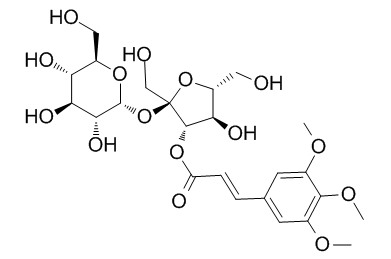Glomeratose A
Glomeratose A is a lactate dehydrogenase inhibitor.
Inquire / Order:
manager@chemfaces.com
Technical Inquiries:
service@chemfaces.com
Tel:
+86-27-84237783
Fax:
+86-27-84254680
Address:
1 Building, No. 83, CheCheng Rd., Wuhan Economic and Technological Development Zone, Wuhan, Hubei 430056, PRC
Providing storage is as stated on the product vial and the vial is kept tightly sealed, the product can be stored for up to
24 months(2-8C).
Wherever possible, you should prepare and use solutions on the same day. However, if you need to make up stock solutions in advance, we recommend that you store the solution as aliquots in tightly sealed vials at -20C. Generally, these will be useable for up to two weeks. Before use, and prior to opening the vial we recommend that you allow your product to equilibrate to room temperature for at least 1 hour.
Need more advice on solubility, usage and handling? Please email to: service@chemfaces.com
The packaging of the product may have turned upside down during transportation, resulting in the natural compounds adhering to the neck or cap of the vial. take the vial out of its packaging and gently shake to let the compounds fall to the bottom of the vial. for liquid products, centrifuge at 200-500 RPM to gather the liquid at the bottom of the vial. try to avoid loss or contamination during handling.
Universitat Stuttgart2022, opus-12200.
J Pharm Biomed Anal.2019, 172:268-277
Inflammation2015, 38(1):445-55
Biomed Pharmacother.2022, 145:112410.
Int J Anal Chem.2017, 2017:1254721
Food Analytical Methods2017, 10:3225-3234
Phytomedicine Plus2022, 2(1):100207.
Molecules.2017, 22(12)
STAR Protoc.2024, 5(2):102990.
Foods.2022, 11(12):1708.
Related and Featured Products
J Sep Sci. 2017 Mar;40(6):1385-1395.
Bioactivity screening, extraction, and separation of lactate dehydrogenase inhibitors from Polygala tenuifolia Willd. based on a hyphenated strategy.[Pubmed:
28134488 ]
Stroke is the second leading cause of death worldwide. Lactate dehydrogenase inhibitors are currently widely used in the treatment of ischemic stroke, and natural products are considered promising sources of lactate dehydrogenase inhibitors.
METHODS AND RESULTS:
In this study, ultrafiltration liquid chromatography coupled with mass spectrometry was used for the screening and identification of lactate dehydrogenase inhibitors from Polygala tenuifolia. Furthermore, five lactate dehydrogenase inhibitors, sibiricose A5, 3,6'-di-O-sinapoyl-sucrose, Glomeratose A, tenuifoliside B, and tenuifoliside C, were selected as target lactate dehydrogenase inhibitors. In addition, the five target compounds with purities of 96.45, 97.65, 96.38, 94.34, and 93.29% were extracted and isolated using a new hyphenated strategy of microwave-assisted extraction coupled with countercurrent chromatography with a two-phase solvent system of n-hexane/n-butanol/ethanol/water (5.321:1.00:1.664:6.647). The bioactivities of the isolated compounds were analyzed using PC12 cells and the 3-(4,5-dimethylthiazol-2-yl)-2,5-diphenyltetrazolium bromide assay.
CONCLUSIONS:
The results also demonstrated that microwave-assisted extraction coupled with countercurrent chromatography is an efficient method of isolating chemical constituents from medicinal herbs. Moreover, the research route consisting of activity screening, extraction, separation, and activity verification of the compounds has the advantages of being efficient, orientated, and objective.
Molecules. 2017 Dec 20;22(12). pii: E2276.
UPLC Quantitative Analysis of Multi-Components by Single Marker and Quality Evaluation of Polygala tenuifolia Wild. Extracts.[Pubmed:
29261155 ]
The quality control of Polygala tenuifolia Wild. is a major challenge in its clinical application. In this paper, a new strategy for the quality evaluation of P. tenuifolia extracts was verified through reverse-phase ultra-performance liquid chromatography (UPLC).
METHODS AND RESULTS:
The quantitative analysis of multi-components by a single marker (QAMS) was conducted with 3,6'-disinapoyl sucrose as an internal reference substance. Eight components (i.e., sibiricose A5, sibiricose A6, Glomeratose A, tenuifoliside A, tenuifoliside B, tenuifoliside C, sibiricaxanthone B, and polygalaxanthone III) were determined based on the relative correction factors. The concentrations of these components were also determined by applying a conventional external standard method. The cosine value confirmed the consistency of the two methods (cosine ratio value >0.999920). Hierarchical cluster analysis, radar plots, and discriminant analysis were performed to classify 23 batches of P. tenuifolia extracts from Shanxi, Hebei, and Shaanxi in China.
CONCLUSIONS:
Results revealed that QAMS combined with radar plots and multivariate data analysis could accurately measure and clearly distinguish the different quality samples of P. tenuifolia. Hence, QAMS is a feasible and promising method for the quality control of P. tenuifolia.



